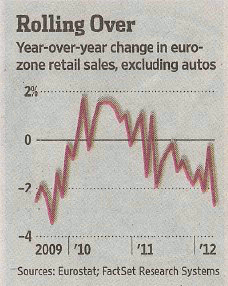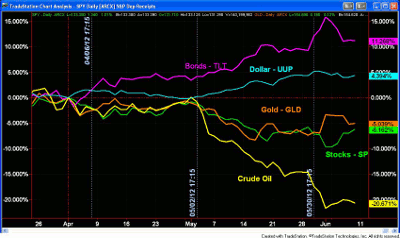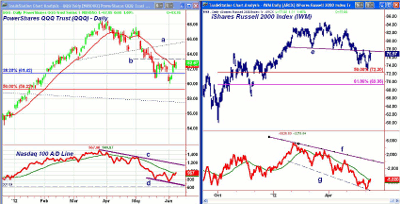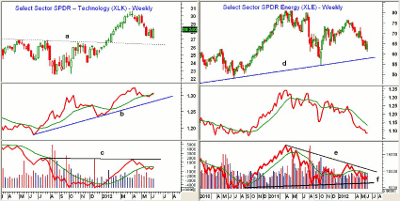We may finally have hit a low, so investors should have their tinder dry. Those looking for ideas on where to invest can consult any of the dozen or so stocks recommended by MoneyShow's Tom Aspray.
Heading into last Monday's opening in the global stock markets, the tone was decidedly ugly. US stocks had finished the prior week sharply lower on the poor jobs data. Instead, the market absorbed the selling fairly well, as the futures lost another ten points in early trading, but closed with little change.
From a technical standpoint, it was important that the major averages like the S&P 500 and Dow Industrials violated the May 18 lows. Then it allowed one to compare the level of selling in May with the selling last Monday.
As I noted last week, "Not all of the Advance/Decline (A/D) lines have made new lows with prices, and the McClellan Oscillator is still well above its recent lows. Of course, before a tradable low can be formed, we need to see the formation of positive divergence followed by an impressive rally."
Though last Wednesday's rally was clearly impressive (the Dow's second best day this year), the positive divergences in the NYSE A/D line have not yet been confirmed. A short-term low has been confirmed by the McClellan oscillator, and together they do suggest that the worst of the selling is over.
This comparative performance chart gives us a good look at how the key markets have performed since the start of April. There are three turning points I have highlighted that identify turns in the various asset classes
On April 6, iShares Trust Barclays 20+ Year Treasury Bond Fund (TLT) crossed above PowerShares DB $ Bull ETF (UUP). TLT is up 11.2% since April, with UUP up 4.3%. Both look pretty good when compared to the 6.1% drop in the SPY.
In early May, crude oil turned down from the zero line and dropped below both the Spyder Trust (SPY) and SPDR Gold Trust (GLD). As the chart shows, crude oil is currently down over 20.6% since the start of April, which bodes well for gasoline prices during the summer.
The decline in crude oil has been contrary to the normal seasonal pattern but the technical weakness was evident by April 20. I think that the majority of selling in crude is likely over, but as I discuss later, there are no signs that one should be aggressively buying the energy stocks.
At the end of May, GLD crossed above SPY, and is still 1% higher. This may be a sign that gold is closer now to bottoming and as I discussed Friday, there are signs that some of the gold bulls have become more negative.
In the Eurozone, the focus was on Spain. Their borrowing costs are uncomfortably high, and there are many concerns about how they are going to bail out their ailing banks.
No one has a clear idea on how much they will need. Fitch is looking at maybe ?60 billion, but Moody's estimate is ?320 billion. Rumors were floating late Friday that they may ask for help during a Saturday conference call.

There was little in the way of positive news in the Eurozone economies, as the chart of Eurozone retail sales (excluding autos) shows a clear downtrend after topping in 2010. Even the Chinese are worried: the head of their $400 billion sovereign wealth fund is pulling back on Eurozone investments, just in case there is a breakup.
China caught the markets by surprise by cutting rates on Thursday for the first time since December 2008. The initial reaction was quite positive, but with key economic data for May being released over the weekend, some of the Asian markets were worried that it may be a sign that China's economy is slowing faster than most thought.
This rate cut should have a very positive impact on China's economic growth, though it may take a few months to manifest itself. If the weekend numbers are really bad, it is likely to impact trading early Monday.
The economic calendar is a bit heavier this week. Import and Export prices are out on Tuesday, followed Wednesday by the Producer Price Index and retail sales. Most are looking for a modest increase for May, and a stronger than expected reading would help balance out some of the recent weak economic data.
The Consumer Price index is out Thursday, along with the latest numbers on jobless claims. Friday brings the Empire State Manufacturing Survey, industrial production, and consumer sentiment.
|pagebreak|WHAT TO WATCH
After breaking their 38.2% support levels, the selling in the major averages has not been as heavy as I expected. This, combined with the improvement in the market internals, suggests we may not test the 50% retracement support levels.
The major averages did test the support from last fall's highs before the market bounced. Last Wednesday, the number of bullish financial newsletter writers dropped over 4% to 34%. Without Wednesday's sharp rally, we probably would have seen a larger drop.
According to the American Association of Individual Investors (AAII), 45% of individual investors are now bearish, but this number can climb to over 50% at important market bottoms.
Despite some early selling, stocks held up well on Friday, as the major averages closed near the day's highs. If the positive divergences in the Advance/Decline (A/D) lines can be confirmed in the next few days, it will further improve the outlook. If not, we are likely to see some backing and filling before stocks complete the bottoming process.
S&P 500
The Spyder Trust (SPY) hit a low of $127.14 early Monday, but traded as high as $133.53 last Thursday. This was a bounce of 5% from the lows.
There is key short-term resistance now at $133.93 (line b). A move above this level is the first step in starting a new uptrend, and it could signal a rally back to former support, now resistance, in the $137 to $138 area (line a).
There is first good support now in the $130.40 to $130.50 area, and then at the gap between $129.70 and $130. Additional support waits at last Monday's close of $128.10.
The lower lows in prices were not confirmed by the S&P 500 A/D line, as it formed a bullish divergence by not making new lows. A move in the A/D line above the intervening peak (line d) will confirm the divergence.
The A/D line did move above its still-declining WMA on Friday. The A/D line needs to overcome the downtrend (line c) to signal that a new intermediate-term uptrend is underway.
Dow Industrials
The SPDR Diamonds Trust (DIA) was hit harder on the last decline, coming very close to the $120 level before prices turned around. So far, it has held above the more important 50% support level at $118.56.
The Dow Industrials' A/D line formed a negative divergence at the May 1 highs (line f), and did make marginal new lows last week even though the support from last fall (line g) held. The A/D line needs to overcome the bearish divergence resistance at line f to signal a new uptrend.
There is further resistance for DIA now at $125.80, and then in the $126.20 to $126.50 area (line e). There is first good support and the still-rising 200-day MA in the $122.60 area.
NEXT: Nasdaq, Sector Focus, and Tom's Outlook
|pagebreak|Nasdaq-100
Monday's low of $60.04 in the PowerShares QQQ Trust (QQQ) came very close to the 200-day MA. The 38.2% support was violated on May 17. So far, QQQ has held well above the 50% Fibonacci retracement support at $59.22.
Last Thursday, QQQ came close to next strong resistance at $63.50, which also corresponds to its former long-term uptrend. Regaining this uptrend would be an encouraging sign. There is additional resistance at $65.60 (line a) and the downtrend from the April-May highs.
The Nasdaq-100 Advance/Decline (A/D) line did make convincing new lows on Monday (line d), but did manage to close the week above its WMA. The downtrend (line c) must be overcome to signal that the uptrend in QQQ has resumed.
Russell 2000
The iShares Russell 2000 Index Fund (IWM) came close to its 50% retracement support at $72.30 on Monday, reaching a low of $72.94.
The prior swing high and further chart resistance (line e) is in the $77.80 to $78 area. More important resistance stands in the $79.50 to $80 area.
The Russell 2000 A/D line also made convincing new lows last week (line g), and is well below the major resistance at line f. It is likely to bottom after the other major averages.
There is now first support for IWM in the $74.50 area.
Sector Focus
The iShares Dow Jones Transportation Average Index Fund (IYT) made new lows last week with the Dow Industrials, so no divergence in terms of Dow Theory. It has rebounded nicely, and a close above $92.50 will improve its outlook.
The best performer last week was the beaten-down Select Sector SPDR Financials (XLK), as it gained over 5%, followed by an over 4% gain in the Select Sector SPDR Materials (XLB).
Though the Select Sector SPDR Technology (XLK) was up just over 3%, the weekly chart does look quite interesting. The correction appears to be holding well above the long-term breakout level (line a) at $26.40.
The weekly relative performance, or RS analysis has turned positive by moving back above its WMA. It has held well above its uptrend (line b). The on-balance volume (OBV) is still below its WMA, but could turn positive with strong volume this week. A breakout above the resistance (line c) would be very positive.
The Select Sector SPDR Energy (XLE) was up close to 3.5% last week, but the weekly chart still looks pretty bad. XLE is down 15% from its February high of $76.23.
The RS line shows a pattern of lower lows and is well below its sharply declining WMA. The weekly OBV does look better as it has been holding above the long-term support at line e. It needs to move through its downtrend (line d) to turn positive.
The Select Sector SPDR Consumer Staples (XLP) was up 2.2% and long positions were recently recommended. The Select Sector SPDR Health Care (XLV) gained 2.7% last week, and my buy levels in a couple of drug stocks were also hit.
NEXT: Commodities and Tom's Outlook
|pagebreak|Crude Oil
Crude oil closed the week higher for the first time in the past six weeks, but was up only just over $1 per barrel. There is next major support, from the summer of 2011, sits in the $77 to $78 area.
Precious Metals
There was some early selling Friday in the SPDR Gold Trust (GLD), but it closed on a firm note. I discussed in detail the weekly and daily technical outlook for GLD in Friday's column.
The Week Ahead
Last week's action in the stock market was quite encouraging, but the technical evidence is not strong enough yet to suggest that one should jump back in the stock market with both feet. Certainly, there are many more attractive looking stocks charts now than there were a week ago.
Many stocks have already bounced from support, so I would wait for pullbacks before buying. I would not expect most stocks to violate their recent lows. In the past two weeks, I have added at least 12 new stocks to the portfolio and I reviewed several of them last week.
If I am correct, and the stock market is going to move significantly higher by the end of the year, now is a good time to plan out how much you would like to have invested in stocks. Of course, it would be better if you had done this before now, but it is never too late.
I suggest you think about how much you want in those stocks with attractive yields, and how much you plan on having in growth stocks from the best-performing sectors.
If the worst of the selling is actually over, you should still have some time to get invested. As always, it is good to be a patient investor or trader.
- To view the current Charts in Play portfolio, click here.
- And don't forget to read this week's Trading Lesson, 80-Year-Old Wisdom That Still Works















